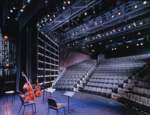149th Street–Grand Concourse station
1917 establishments in New York CityFuture accessible New York City Subway stationsIRT Jerome Avenue Line stationsIRT White Plains Road Line stationsMott Haven, Bronx ... and 9 more
National Register of Historic Places in the BronxNew York City Subway stations in the BronxNew York City Subway stations located undergroundNew York City Subway transfer stationsRailway and subway stations on the National Register of Historic Places in New York CityRailway stations in the United States opened in 1905Railway stations in the United States opened in 1917Source attributionUse mdy dates from January 2017

The 149th Street–Grand Concourse station is a New York City Subway station complex shared by the IRT Jerome Avenue Line and the IRT White Plains Road Line. It is located at East 149th Street and Grand Concourse in Mott Haven and Melrose in the Bronx. The complex is served by the 2 and 4 trains at all times, and by the 5 train at all times except late nights.
Excerpt from the Wikipedia article 149th Street–Grand Concourse station (License: CC BY-SA 3.0, Authors, Images).149th Street–Grand Concourse station
Grand Concourse, New York The Bronx
Geographical coordinates (GPS) Address Nearby Places Show on map
Geographical coordinates (GPS)
| Latitude | Longitude |
|---|---|
| N 40.8181 ° | E -73.9275 ° |
Address
149th Street-Grand Concourse
Grand Concourse
10451 New York, The Bronx
New York, United States
Open on Google Maps










